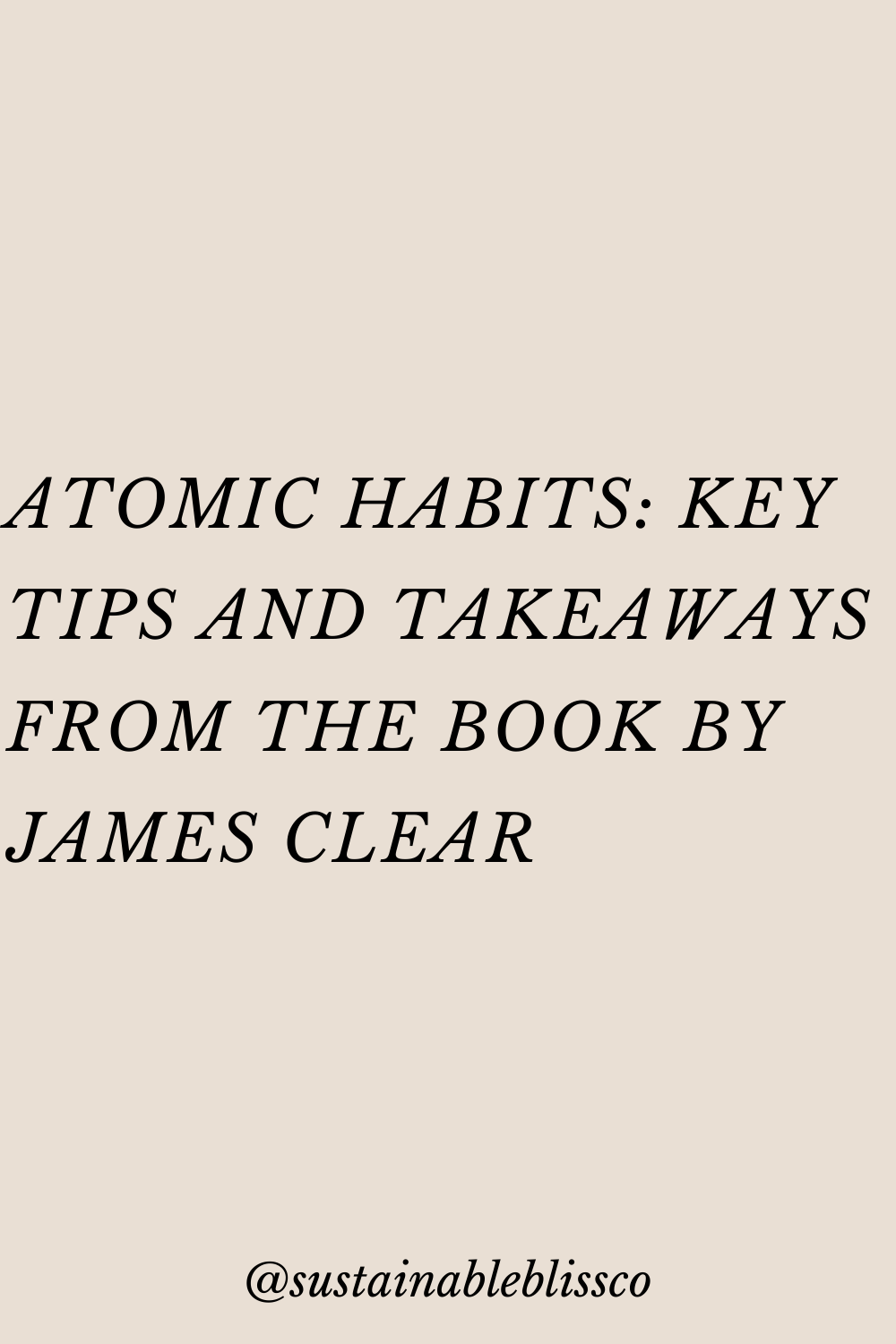atomic habits: key tips and takeaways
an easy and proven way to build good habits & break bad ones by james clear
written by Jasmine Irven
A number of habits make up your daily life; everything from the fact that you no longer need to be reminded to brush your teeth in the morning, to picking up your phone 50 times instinctively when it’s sitting beside you (even though you’re trying oh so hard to focus on your work).
These habits are routines or behaviours that are performed regularly, and in many cases automatically.
While some of the habits you’ve established over the years may be positive, it’s likely that if you review or reflect on your day you’ll notice a number of areas that could use improvement, or a number of habits that don’t support your higher self, or the identity you’d like to embody.
This book is a super tangible overview of how you can begin making these shifts in your life: breaking bad habits and creating new ones that you’re able to stick to.
Simple, sustainable change is what we’re all about here at Sustainable Bliss, so this book is the perfect way to reinforce that concept!
We’re always looking for new ways to upgrade our systems and mindsets for more success in achieving our big goals and pursuing a life that matters, and this book provides a simple guide for doing just that.
Below are some of my key takeaways and favourite quotes from the book, which I hope are helpful for providing some guidance and inspiration for you as you work to change your habits: either breaking bad habits that are no longer serving you, or creating new habits that support your health and wellbeing.
And, if these takeaways do inspire you, I’d definitely recommend reading the book in its entirety.
why habits matter
Habits are those routines or rituals we do daily, often without thinking about them. Habits make up our days, meaning that in the long run, the quality of our lives, and what we spend our time doing depends on the habits we’ve developed.
If we can spend the time being a little bit more intentional about what habits we’re cultivating, and what habits aren’t serving us, we can create remarkable change.
Instead of creating this change drastically by resolving to change your entire life and all of your habits overnight by giving yourself a to-do list of 15+ new things you want to try (which I’m often guilty of), Clear advocates for this concept of the “aggregation of marginal gains”; this philosophy of “searching for a tiny margin of improvement in everything you do.”
Because making small improvements isn’t particularly notable, this concept is often underestimated. But the reality is, when you aim to improve by 1%, it’s pretty difficult to fail.
On the other hand, when you overestimate your abilities and set out to make this drastic change, it’s easy to become overwhelmed and not do anything at all. Or, to keep up the new habit for approximately 2 days before going back to your old ways.
Habits are the compound interest of self-improvement; the effects of your habits multiply as you repeat them… [on the other hand] when we repeat 1 percent errors, day after day, by replicating poor decisions, duplicating tiny mistakes, and rationalizing little excuses, our small choices compound into toxic results.
— James Clear
on outcomes
Your choices today determine the difference between who you are and who you could be, which is why Clear advocates for this idea of being more concerned with your current trajectory rather than results.
Your outcomes are a lagging measure of your habits - meaning you get what you repeat. When you continue to make choices that support the person you want to be, you’ll continue to grow, improve, learn, and better yourself.
If instead you feed your life with bad habits or avoidance, you’re going to continue on the same or a downward trajectory, meaning it will take more time to pull yourself back out.
Resolve to start today. Knowing that each choice you make can either be a positive vote for this person you want to be; this identity you want to embody, or a negative vote, keeping you stuck; feeling hopeless, or that this reality is your destiny.
on the valley of disappointment
Let me know if this sounds familiar: you start a new habit and actually stick to it for a few days, but (surprise) nothing changes. You maybe stick to it a few more days but when “yep”, inevitably there is still no change, your brain says something like “I told you this wouldn’t work - what’s the point?” And you lose any motivation you have to keep up with the habit.
Clear refers to this state and/or transition period as the valley of disappointment: it can be frustrating how ineffective changes can seem during the first few days, weeks, or months of starting a new habit. It doesn’t feel like you’re going anywhere.
But, it’s important for us to remember that the most powerful outcomes are delayed. Your habits need to persist long enough to break through this plateau. “Your work is not wasted, it is just being stored.”
on creating systems not goals
Often times we try to motivate ourselves by setting huge goals; only declaring success when we reach that point. Instead, Clear talks about the importance of creating systems that serve you throughout the entire process.
When you fall in love with the process, you aren’t waiting for a specific result before you are “happy” or “successful”. Ultimately, it is your commitment to the process that will determine your progress.
“The purpose of setting goals is to win the game. The purpose of building systems is to continue playing the game.”
on habits + identity
In a similar vein, when you focus your habits on specific outcomes, the focus is on what you want to achieve; a very binary thing: “yes I got it” or “no I didn’t”.
Instead, Clear speaks about the importance of identity-based habits; habits that place the focus on who you wish to become. Often times we are attached to old identities - we are a “smoker” not a “runner” and these labels dictate our current and future behaviour. Every belief, including those about yourself, is learned and conditioned through experience, and the more you repeat a behavior, the more you reinforce the identity associated with that behaviour.
It’s hard to change your habits if you never change the underlying beliefs that led to your past behaviour. “No thanks. I’m not a smoker”... signals a shift in identity. Smoking was part of their former life, not their current one. They no longer identify as someone who smokes.
Know that you can change. Know your identity can shift. Every action you take is a vote for the type of person you wish to become, and as the votes build up, so does the evidence of your new identity.
The ultimate form of intrinsic motivation is when a habit becomes part of your identity. It’s one thing to say I’m the type of person who wants this. It’s something very different to say I’m the type of person who is this. The goal is not to run a marathon, the goal is to become a runner.
— James Clear
Nothing changes if nothing changes. Decide the type of person you want to be. Decide what you want to stand for.
Then, work backwards and determine what decisions you need to make to get there. Prove it to yourself with small wins. Choose this new identity. Reinforce it with the habits you choose each day.
on building better habits
Before we can effectively build new habits, we need to get a handle on our current ones, because if all the habits that make up your daily life remain mindless, you can’t expect to improve them. Make a list of your daily habits and ask yourself: is this a good habit, a bad habit, or a neutral habit. Does this behavior help me become the type of person I wish to be? Does this habit cast a vote for or against my desired identity?”
Begin recognizing your bad habits and the cues that trigger them. Create an implementation intention: “When situation X arises, I will perform response Y.” People who make a specific plan for when and where they will perform a new habit are more likely to follow through.
rules of habit formation
make it obvious
Visual cues are the greatest catalyst of our behavior. Put the fruit out on the table, leave your workout clothes out the night before. Ensure you see the cues that will get you to act. Design your environment to encourage the positive habit by sprinkling triggers throughout your surroundings. Make sure the best choice is the most obvious one.
Spend less time in tempting situations. If you have a bad habit, the urge to act is almost impossible to ignore when the environmental cues appear. “Watching television makes you feel sluggish, so you watch more television because you don’t have the energy to do anything else. It’s a downward spiral, a runaway train of bad habits.”
Resisting temptation is an ineffective strategy. Instead, reduce exposure to whatever cue causes the behaviour (leave your phone in another room, put the cookies in the back of a cupboard, etc.).
make it irresistible
The more attractive an opportunity is, the more likely it is to become habit-forming. Try temptation bundling: linking an action you want to do with an action you need to do. You’re more likely to find a behavior attractive if you get to do one of your favorite things at the same time!
Look at underlying motives of bad habits (passed down from our ancestors): to conserve energy, obtain food and water, find love and reproduce, connect and bond with others, win social acceptance and approval, etc. Which motives are driving your habit? Your current habits are not necessarily the best way to solve the problems you face; they are just the methods you learned to use.
Once you associate a solution with the problem you need to solve, you keep coming back to it. Work on reframing the more positive solutions to these motives as things you are excited about or “get to do” - you don’t have to work out, you get to build stronger muscles!
[Looking to start meditating?] Find something that makes you truly happy—like petting your dog or taking a bubble bath—and then create a short routine that you perform every time before you do the thing you love. Maybe you take three deep breaths and smile. Three deep breaths. Smile. Pet the dog. Repeat. Eventually, you’ll begin to associate this breathe-and-smile routine with being in a good mood. It becomes a cue that means feeling happy.
— James Clear
make it easy
“All habits follow a similar trajectory from effortful practice to automatic behavior, a process known as automaticity. Automaticity is the ability to perform a behavior without thinking about each step, which occurs when the non-conscious mind takes over...to build a habit, you need to practice it.”
Make your habits as easy as possible to start, because once you’ve started doing the right thing, it’s much easier to continue doing it.
Energy is precious, and the brain is wired to conserve it whenever possible. It is human nature to follow the Law of Least Effort, which states that when deciding between two similar options, people will naturally gravitate toward the option that requires the least amount of work...the less energy a habit requires, the more likely it is to occur... When you start a new habit, it should take less than two minutes to do.
— James Clear
If you’re struggling to make a habit easy, it may be better to focus on making the bad habits hard. “The best way to break a bad habit is to make it impractical to do. Increase the friction until you don’t even have the option to act.”
make it satisfying
We are more likely to repeat a behavior when the experience is satisfying. “Feelings of pleasure—even minor ones are signals that tell the brain: “This feels good. Do this again, next time.” Pleasure teaches your brain that a behavior is worth remembering and repeating.”
When you make a habit satisfying it increases the odds that you’ll repeat it in the future. So often we’re looking for immediate satisfaction, but so many of the best habits have a delayed return (you don’t notice changes in your body until a month or two of exercising, etc.), and therefore instant gratification normally wins in the moment. So, add a little bit of immediate pleasure to the good habits. Skip the donut? Add $5 to a massage fund. Both of these actions (skipping the donut and getting a massage) are votes for the same identity - taking care of your body).
Once the habit is done enough you will start to see the long term effects (i.e. how much more energy you have when you eat healthy), and then you’ll continue to do it because it’s who you are and it feels good.
“If you’re willing to wait for the rewards, you’ll face less competition and often get a bigger payoff. it’s possible to train yourself to delay gratification—but you need to work with the grain of human nature, not against it. The best way to do this is to add a little bit of immediate pleasure to the habits that pay off in the long-run and a little bit of immediate pain to ones that don’t.”
— James Clear
final thoughts
Over time, habits are what make up your life. Each day you have the ability to make choices that support the identity you want to embody.
Focus on how you can continue to get 1 percent better.
Small changes compound over time. Small changes are simple, so you have no excuse not to do them.
Make your habits obvious, attractive, easy, and satisfying. Learn to love the process, rather than getting attached to an outcome. And never stop making improvements.
Sustainable Bliss Collective endorses products & brands we genuinely love and support. If you end up making a purchase through one of our affiliate links, it will not cost you anything but we may earn a commission. Learn more here.
share this on Pinterest!
about the author
Hey there! I’m Jasmine, founder of the Sustainable Bliss Collective, a Certified Meditation Teacher, and lover of all things self-care, slow-living, and personal development.
I believe that ambition and self-care can coexist, and as such I hope to encourage and inspire you to take care of yourself, breathe deeply, connect with who you are, manifest your dreams, enjoy the blissful moments of each day, and make an impact in this beautiful world we call home.
Connect with me on Instagram here!






